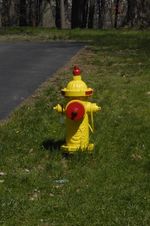Tag:emergency=fire_hydrant
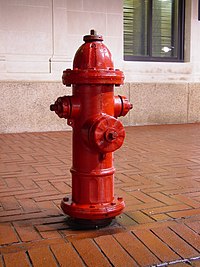 |
| Description |
|---|
| An active fire protection measure, and a source of water provided in most urban, suburban, and rural areas with municipal water service to enable fire fighters to tap into the municipal water supply to assist in extinguishing a fire. |
| Group: emergencies |
| Used on these elements |
| Useful combination |
| See also |
| Status: approved |
| Tools for this tag |
|
The tag emergency=fire_hydrant is used to map a ![]() fire hydrant: a device to take water for firefighting purposes. A fire hydrant is an active fire protection measure, and a source of water provided in most urban, suburban, and rural areas with municipal water service to enable firefighters to tap into the municipal water supply to assist in extinguishing a fire. It can be pressurised or unpressurised. It may also be known as a fire plug or johnny pump.
fire hydrant: a device to take water for firefighting purposes. A fire hydrant is an active fire protection measure, and a source of water provided in most urban, suburban, and rural areas with municipal water service to enable firefighters to tap into the municipal water supply to assist in extinguishing a fire. It can be pressurised or unpressurised. It may also be known as a fire plug or johnny pump.
Not to be confused with a emergency=fire_service_inlet. These inlets do not provide water, on the contrary, they are used to pump water up a building.
A designated place where fire engines can park to pump water from a body of water (such as a river or lake), is mapped with emergency=suction_point (see the wiki page for that tag). If there is also a pipe present to make it easier to pump water, that pipe can be mapped as a hydrant with appropriate water_source=* and fire_hydrant:pressure=suction (see below).
How to map
For numeric values with units, see the guidelines: Map Features/Units
Basic tags
| Tag | Description | Valid values |
|---|---|---|
emergency=fire_hydrant
|
Tag a node with this tag to identify the location of a fire hydrant. | |
fire_hydrant:type=*
|
The shape of the hydrant. See the table below for details. | pipe, pillar, wall, underground |
fire_hydrant:pressure=*
|
Pressure at which the water is supposed to flow through the hydrant.
If under pressure but you don't know the value If the hydrant is connected to a pond/stream/tank/pool and a pump is needed to get water, use If this tag is not specified, pressure is assumed to be unknown. Note: 100 lb/sq in ≅ 6.985 bar |
# (numeric value) in bar/yes/suction |
fire_hydrant:type=* details
| Value | Description | Examples |
|---|---|---|
pipe
|
Hydrant consisting of a simple capped pipe, without the usual hydrant shape | 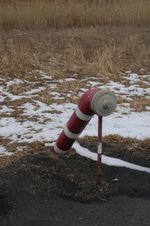
|
pillar
|
A pillar type hydrant. If you want to be more specific, see details below. | 
|
wall
|
A wall-mounted fire hydrant. Be careful not to confuse this with Tag:emergency=fire_service_inlet, which are common in urban settings. | 
|
underground
|
A simple fire hydrant outlet located underground, below a metal cap. Discerning coupling types or sizes can be determined by reading the cap inscription or by raising the cap. There may be other types of objects hidden below these caps such as measuring points (e.g. labelled "GWM") or natural gas (labelled "Gas"). Hydrants are, of course, labelled "HYDRANT".
In Austria and Germany underground hydrants are of the same type. Inside there is not a normal coupling, but a bayonet coupling where the standpipe is locked in. The coupling should be Bayonet 70 mm throughout the two countries. |
 
|
fire_hydrant:position=* details
| Value | Description | Examples |
|---|---|---|
green
|
The hydrant is surrounded by greens, e.g. in a grass patch. | 
|
lane
|
The hydrant is on the side of a road lane. | 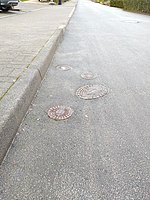
|
sidewalk
|
The hydrant is on a sidewalk. | 
|
parking_lot
|
The hydrant is in a parking. | 
|
Optional tags
All other tags are optional but are useful for firefighting purposes. If you don't know the data, simply don't use these tags.
| Tag | Description | Valid values | Examples |
|---|---|---|---|
fire_hydrant:diameter=*
|
This is the nominal diameter of the underground pipe going along the street that feeds (among other things) the hydrant. In some countries you can read it on the signboard near the hydrant: generally, it is the number on top of the sign.
NB: Do not confuse the number printed on the sign with the number that is printed on the hydrant, that instead is generally the diameter of the flanged connection between the hydrant and the underground pipe. This diameter currently is NOT tagged. |
# (numeric value) in mm, inches ("), or letters.
|
 |
flow_rate=*
|
Nominal flow rate. If fire_hydrant:awwa_class=* is present, this tag is redundant.
|
# (numeric value) with unit of measure, in International System standard unit is m3/s, but for hydrants are preferable l/min (liters per minute), usgal/min (US gallons per minute), ukgal/min (UK gallons per minute), or m3/h (cubic meters per hour). For example, flow_rate=600 l/min.
In France, a normalized fire hydrant needs to supply 120 m3 during two hours. In the United States, this specification is in gallons per minute. The use of usgal/min or ukgal/min instead of gpm is necessary because UK and US gallons are different. | |
fire_hydrant:awwa_class=*
|
In the US, classification per American Waterworks Association. If flow_rate=* is present, this tag is redundant. See the table below for details.
|
AA, A, B, C
|
|
couplings=*
|
Number of couplings. | # (numeric value) | 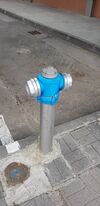 |
couplings:type=*
|
Coupling standard. | Bayonet, Barcelona, Guillemin, Klaue, Sprawny, Storz, UNI
More types are described at: Hose coupling on Wikipedia |
|
couplings:diameters=*
|
Each coupling diameter, delimited by semicolons. | #;#;# (numeric values). Always specify the unit of measure, normally use mm. For inches use ". In some countries characters A, B, C are used to specify the connector (e.g.: taken this image & guessing diameters, this could result in: |
|
pillar:type=*
|
For better description of pillar hydrants, in addition to fire_hydrant:type=pillar. See below for details.
|
dry_barrel, wet_barrel
|
|
water_source=*
|
The water source for the hydrant. | main, stream, river, canal, drain, ditch, pond, lake, water_tank, swimming_pool, groundwater, … "main" means a hydrant connected to a pipe that is fed by the local distribution network.
"groundwater" is for water wells. This list may not be exhaustive. As a rule of thumb, the value of |
|
water_tank:volume=*
|
Volume of the water reserve, applicable only in conjunction with water_source=water_tank or water_source=swimming_pool.
|
The page for emergency=fire_hydrant and the one for emergency=water_tank have declared different default units for water_tank:volume in the past; it is therefore perhaps preferable to always explicitly specify a unit. | |
survey:date=*
|
Date of the last site survey (this tag is not specific to fire hydrants). This means that someone observed the hydrant at this location on this date. This does not imply that a functional check was done at that time. For the date of last functional check, another tag (not yet defined) will be necessary. | YYYY-MM-DD
|
|
colour=*
|
The colour of the hydrant. Unless otherwise specified, the entire hydrant is this colour. | blue, green, yellow and red are the valid values in the AWWA scheme, but many jurisdictions do other things | |
bonnet:colour=*
|
Colour of the top section ("bonnet") of the fire hydrant if different from the colour tag value. | blue, green, yellow and red are the valid values in the AWWA scheme, but many jurisdictions do other things | |
cap:colour=*
|
Colour of the caps of the fire hydrant if different from the colour tag value. The caps are the covers over the hose openings. | blue, green, yellow and red are the valid values in the AWWA scheme, but many jurisdictions do other things. If caps are painted in more than one colour, list all colours separated by semicolons | |
reflective:colour=*
|
Colour of reflective material, if any (commonly stripes or bands around the barrel). | ||
disused:emergency=fire_hydrant
|
Hydrants are supposed to be in service by default. If the hydrant is out of service, use a lifecycle prefix: replace emergency=fire_hydrant with this tag.
|
||
manufacturer=*
|
To retrieve information from manufacturers' documentation. This tag is not specific to fire hydrants. | ||
model=*
|
To retrieve information from manufacturers' documentation. This tag is not specific to fire hydrants. | ||
fire_hydrant:count=*
|
Number of hydrants if there are more than one. Anyway, it is preferable to tag each hydrant with its own node (according the OSM principle of "one feature, one element"). | # (numeric value) | |
fire_hydrant:style=*
|
For special designs. | wsh, …
|
|
ref=*
|
Reference number, if applicable. | # (numeric value) | |
name=*
|
Name, if applicable. | ||
fire_hydrant:opening=*
|
Direction to open the valve. Indicated in the corner of the signage in Hungary with a round arrow. | cw (clockwise), ccw (counter-clockwise)
|
fire_hydrant:awwa_class=* details
AWWA, short for American Water Works Association. Wet Hydrants are generally fed by water mains in urban and suburban areas. The dimensions of the mains vary greatly, and so the flow capacity of the hydrants can vary substantially. The location of hydrants is the first requirement in a mutual assistance call; the second most important piece of information is the flow capacity. Some jurisdictions in the United States have adapted a colour scheme specified by the American Water Works Association. In these jurisdictions, flow capacity may be determined simply by examining the colour of the bonnet and caps of a fire hydrant. In other cases, finding out the capacity may be more difficult.
| Class | Flow Capacity | Bonnet & Caps Colour |
|---|---|---|
| AA | more than 1500 US gal/min | Light blue |
| A | between 1500 and 1000 US gal/min | Green |
| B | between 1000 and 500 US gal/min | Yellow |
| C | less than 500 US gal/min | Red |
pillar:type=* details
Deprecated tags
| Under no circumstances should you automatically (or semi-automatically) change "deprecated" tags to something else in the database on a large scale without conforming to the Automated Edits code of conduct. Any such edits will be reverted. |
amenity=fire_hydrantis deprecated because it has been replaced byemergency=fire_hydrant.fire_hydrant:type=pondis deprecated because it has been replaced bywater_source=pond.- This because "pond" is the water supply, not the physical delivery mechanism (like underground/pillar/wall).
in_service=<yes/no>is deprecated because it has been replaced bydisused:emergency=fire_hydrant- This because the prefix
disused:*=*is already used in other contexts and indicates the same concept.
- This because the prefix
fire_hydrant:flow_capacity=*is deprecated because it has been replaced byflow_rate=*.fire_hydrant:class=*is deprecated because it has been replaced byfire_hydrant:awwa_class=*.- This because it was not immediately clear to which standard this class refers to.
fire_hydrant:water_source=*is deprecated because it has been replaced bywater_source=*.- This because a generic tag for water source can be useful for other features (
emergency=suction_pointand virtually others).
- This because a generic tag for water source can be useful for other features (
How to find an underground fire hydrant: signage

- Germany: Hinweisschilder zu Straßeneinbauten#Hinweisschilder für Hydranten on Wikipedia
- Some other countries: Fire hydrant#Signage on Wikipedia
Possible rendering
![]() suggested by User:Chrisana13
suggested by User:Chrisana13
Maps
- OpenFireMap – Shows all fire stations and hydrants, see OpenFireMap.
- OsmHydrant – Tool for displaying hydrants, see OsmHydrant.
- MapComplete.osm.be – Shows hydrants and fire stations.
- Mapa Abakus – Map showing fire hydrants in Poland.
- Karta01 – Shows all fire stations, rescue stations and hydrants in Belarus, Kazakhstan, Russia, and Ukraine.
- Humanitarian map style
- Shown in Organic Maps and MAPS.ME
- Waldbrand Brandenburg: German website and Android app to view/add hydrants, developed in and for Brandenburg (Germany).
- OSM Carto – none
See also
- Related proposals
emergency=suction_pointemergency=fire_service_inletdiameter=*pressure=*location=*- Colour codes (see Fire hydrant#Appearance on Wikipedia for info, this page for an example)
- Mappa Mercia guide to mapping UK hydrants
